![]()
![]() dallas1:18 PM
dallas1:18 PM
hilarious
![]() dallas1:19 PM
dallas1:19 PM
-1 = 50meters or more underground
![]() daniel valuch1:19 PM
daniel valuch1:19 PM
160 meters where at point 4 of LHC
![]() Dan Maloney1:19 PM
Dan Maloney1:19 PM
And here I was thinking I was being overly enthusiastic with my descriptions of working at CERN
![]() April Morone1:20 PM
April Morone1:20 PM
@Dan Maloney Lol.
![]() daniel valuch1:20 PM
daniel valuch1:20 PM
ok, youtube
![]() dallas1:20 PM
dallas1:20 PM
my ears popped when going down there
![]() daniel valuch1:20 PM
daniel valuch1:20 PM
they installed a counter in the new elevators :-)
![]() daniel valuch1:21 PM
daniel valuch1:21 PM
SPS is different. "only" tens of meters, up to 60 I think. But 24 storeys
![]() Thomas Shaddack1:21 PM
Thomas Shaddack1:21 PM
ever thought about making it faster so you could experience zero-g?
![]() April Morone1:22 PM
April Morone1:22 PM
Awesome.
![]() dallas1:22 PM
dallas1:22 PM
they are very very fast
![]() Dan Maloney1:22 PM
Dan Maloney1:22 PM
At least there's a bathroom right off the elevator
![]() April Morone1:22 PM
April Morone1:22 PM
Hehe
![]() daniel valuch1:22 PM
daniel valuch1:22 PM
@Thomas Shaddack funny enough, exactly the opposite. The elevators are not used very often, when the machine runs, there is no access for months. In this particular one, I got stuck about 15 seconds down every time I was called
![]() daniel valuch1:23 PM
daniel valuch1:23 PM
first time panic. Second time not again... Third time. ok let's wait 20 seconds, it will unstuck itself
![]() dallas1:23 PM
dallas1:23 PM
and have to be triple redundant in their operation because huffing up the stairs in case of an emergency isn't really an option
![]() Thomas Shaddack1:23 PM
Thomas Shaddack1:23 PM
what are the emergencies? helium/nitrogen leak from the magnets?
![]() daniel valuch1:24 PM
daniel valuch1:24 PM
actually CERN is the only place in the world, where you must use the elevator in case of fire. And you must not use the stairs. 160 meters of staircase is good 50 storey skyscraper
![]() daniel valuch1:24 PM
daniel valuch1:24 PM
can you run it up in one go?
![]() dallas1:24 PM
dallas1:24 PM
isnt there a dedicated fire crew for the complex?
![]() caladan1:24 PM
caladan1:24 PM
What kind of radiation protection do you use?
![]() Thomas Shaddack1:25 PM
Thomas Shaddack1:25 PM
I'd guess "couple dozen meters of solid rock shielding"...?
![]() daniel valuch1:25 PM
daniel valuch1:25 PM
@Thomas Shaddack yes, sometimes there is a helium release from the cryogenic system. It is usually collected via the recovery line, valves unfreeze and we carry on. But sometimes there is bigger loss of helium into atmosphere
![]() dallas1:25 PM
dallas1:25 PM
there's a fob everyone I saw wearing around their neck that measures exposure
![]() daniel valuch1:26 PM
daniel valuch1:26 PM
@caladan yes, everything is 100 meters underground. You need to shield the machine from the cosmic rays and the human activity too
![]() caladan1:26 PM
caladan1:26 PM
And the protection for people who have to access the machine?
![]() dallas1:26 PM
dallas1:26 PM
https://photos.app.goo.gl/92vYVaMHXYeyVYS46
GOOGLE
Read this on Google
![]() daniel valuch1:26 PM
daniel valuch1:26 PM
yes, dosimetry is everywhere. But the total absorbed dose for all people working there in a year is a small franction of an annual limit for one person. It is very well organized
![]() dallas1:27 PM
dallas1:27 PM
that is an image of the observation deck in the CMS cavern, the beam tube is within the concrete blocks below
![]() daniel valuch1:28 PM
daniel valuch1:28 PM
there are multiple layers of protection. Biometry, mechanical barriers etc. Even if a door would be forced, the LHC will stop and by the time the offender would have a chance to get to the machine, energy from the magnets will be extracted
![]() daniel valuch1:28 PM
daniel valuch1:28 PM
it is not an easy task if the stored energy in one arc is about a GJ. Hude resistors
![]() twlostow1:29 PM
twlostow1:29 PM
Yeah, for those who saw "angels and demons" movie - there are indeed retina/iris scanners at the LHC/SPS access doors. Everything else in this movie is BS, but the scanners are true.
![]() dallas1:29 PM
dallas1:29 PM
the door interlocks are something... there's an rf fob, iris scanners, etc.
![]() daniel valuch1:29 PM
daniel valuch1:29 PM
and switches of size of a truck. When you stand next to that switch, and it operates when you don't expect it, you may need to change you brown emergency underwear
![]() dallas1:30 PM
dallas1:30 PM
do you have a picture of one of the switches?
![]() dallas1:30 PM
dallas1:30 PM
+
![]() daniel valuch1:30 PM
daniel valuch1:30 PM
let me find one
![]() daniel valuch1:31 PM
daniel valuch1:31 PM
![]()
![]() daniel valuch1:32 PM
daniel valuch1:32 PM
![]()
![]() daniel valuch1:32 PM
daniel valuch1:32 PM
![]()
![]() daniel valuch1:32 PM
daniel valuch1:32 PM
![]()
![]() daniel valuch1:32 PM
daniel valuch1:32 PM
those are only the switch elements, it is built into an enclosure of size of a shipping container
![]() daniel valuch1:33 PM
daniel valuch1:33 PM
and few of the resistors. You dissipate all magnet energy there in 1 minute, then you need to cool it down for more than an hours. If there is a stormy weather in the summer, and there are multiple dumps, it takes time to restart
![]() caladan1:33 PM
caladan1:33 PM
Ah, I've seen those during open days in UA43
![]() twlostow1:34 PM
twlostow1:34 PM
Me too! :-)
![]() dallas1:34 PM
dallas1:34 PM
the red phenolic boxes are the actuators?
![]() twlostow1:34 PM
twlostow1:34 PM
Amazing stuff...
![]() daniel valuch1:34 PM
daniel valuch1:34 PM
yes, that is typical location, In the power converter gallery parallel to the tunnel in all even points
![]() daniel valuch1:35 PM
daniel valuch1:35 PM
@dallas those are arc extinguishing chambers. You are opening a circuit with 300 superconducting magnets at 12kA current
![]() daniel valuch1:35 PM
daniel valuch1:35 PM
not a particularly easy task to do :-)
![]() dallas1:36 PM
dallas1:36 PM
is that chamber within an additional vacuum chamber or immersed in dielectric oil or some such thing?
![]() daniel valuch1:36 PM
daniel valuch1:36 PM
for some applications, they managed to replace them by IGBT switches. But mechanical is better, very low resistance, so multiplied by 12 kiloamps squared, it is not producing a lot of heat
![]() daniel valuch1:37 PM
daniel valuch1:37 PM
no, that is all in air
![]() daniel valuch1:37 PM
daniel valuch1:37 PM
I have seen it to open, it is impressive
![]() dallas1:37 PM
dallas1:37 PM
quite a pop when that thing does it's job...
![]() daniel valuch1:38 PM
daniel valuch1:38 PM
yup... when you think about all the energy you must dispose very quickly in a very controlled way, not an easy job. And you do not want any false positives, it must work only when there is a problem
![]() dallas1:38 PM
dallas1:38 PM
when energized? or actuation not while electrified?
![]() daniel valuch1:39 PM
daniel valuch1:39 PM
my experience was a test stand, not energized. The real arc is difficult to see when energized, there is no access
![]() daniel valuch1:39 PM
daniel valuch1:39 PM
everything is designed to be inherently safe.
![]() twlostow1:40 PM
twlostow1:40 PM
yeah. one sector of the LHC has a few henries (H) of inductance. And a 14kA nominal current. I leave the calculation of the energy stored in the magnets as the homework :D
![]() daniel valuch1:40 PM
daniel valuch1:40 PM
the power converters for dipoles deliver 190V/13kA. But resistive voltage on those coils is exactly zero
![]() daniel valuch1:40 PM
daniel valuch1:40 PM
fascinating :-)
![]() April Morone1:41 PM
April Morone1:41 PM
Agreed.
![]() dallas1:41 PM
dallas1:41 PM
seriously amazing.
![]() daniel valuch1:42 PM
daniel valuch1:42 PM
the quench protection system must detect millivolt of resistive voltage in a presence of volts of L*di/dt, and in a very radioactive environment. Collegues from the magnet protection gorup have no simple job
![]() daniel valuch1:43 PM
daniel valuch1:43 PM
it is mostly digital now
Xasin joined the room.1:43 PM
![]() Xasin1:43 PM
Xasin1:43 PM
How very ironic that I am this late to the hack chat - I was trying out the CERN Choir!
![]() dallas1:44 PM
dallas1:44 PM
![]()
![]() Dan Maloney1:44 PM
Dan Maloney1:44 PM
So, I've got to drop off now, but feel free to keep chatting. Daniel, thanks for the time today, this was great. And thanks to Thomas too -- great insights into the workings of CERN, it was a lot of fun. And thanks to everyone for the great questions. Transcript coming up soon.
![]() daniel valuch1:44 PM
daniel valuch1:44 PM
https://home.cern/news/news/engineering/engineers-refine-protection-system-lhc-magnets
CERN
![]()
This week, the Large Hadron Collider (LHC) was switched off for its second scheduled technical stop since starting to run at the new high energy of 6.5 teraelectronvolts (TeV) per beam. These regular stops allow engineers and technicians to maintain the machine and ensure that all its components are working well.
Read this on CERN
![]() Xasin1:44 PM
Xasin1:44 PM
I'm a Technical Student, just started this month, so I would've loved to soak up some details here ^^
How is it with these kinds of chats, is the transcript available later?
![]() Dan Maloney1:45 PM
Dan Maloney1:45 PM
Yes, I'll be posting a transcript in a few minutes
![]() daniel valuch1:45 PM
daniel valuch1:45 PM
@dallas guess how many square millimeters of super conductring wire carries those 20kA of current in your photo
![]() daniel valuch1:46 PM
daniel valuch1:46 PM
hello xasin, welcome to cern :-)
![]() dallas1:46 PM
dallas1:46 PM
oooh, my host told me that and im now failing the pop quiz. 5?
![]() daniel valuch1:47 PM
daniel valuch1:47 PM
yes, it is maybe 3-5 mm^2. All the rest is just a resistive filler, like copper, or aluminium. Superconductors are impressive
![]() daniel valuch1:48 PM
daniel valuch1:48 PM
the situation however dramatically changes, when the superconductor loses its properties and becomes resistive. Then 5kA/mm^2 is not your friend :-)
![]() dallas1:48 PM
dallas1:48 PM
I remember it being miniscule, especially next to the standard coils used for some of the dipoles.
![]() dallas1:48 PM
dallas1:48 PM
I heard a story...
![]() Xasin1:49 PM
Xasin1:49 PM
Oh, I actually know a little about that! I started in the Quench Detection / Protection systems.
IIRC, when a quench is detected, one of the things you can do is to intentionally make the whole rest of the superconductor ALSO resistive, so that the energy is more evenly dissipated. Was that about right?
![]() daniel valuch1:49 PM
daniel valuch1:49 PM
Our colleagues are working on high temperature superconducting links to bring current from the converters at the surface down to the tunnel. In a cross section corresponding to your palm they transfer 150 kA in maybe 10 different circuits
![]() daniel valuch1:50 PM
daniel valuch1:50 PM
@xasin say hello to Jens and company
![]() dallas1:51 PM
dallas1:51 PM
by high temp, you still mean quite chilly though correct? not high temp as in 30c
![]() daniel valuch1:51 PM
daniel valuch1:51 PM
@Xasin yes, the coil is warmed up, so the energy is dissipated into a large volume, while rest of the current bypasses the quenched coil by a humungous diode
![]() daniel valuch1:52 PM
daniel valuch1:52 PM
@dallas just above the critical temperature. 5 Kelvins can be sufficient
![]() daniel valuch1:52 PM
daniel valuch1:52 PM
5K is hot when you operate at 1.8 :-) everything is relative
![]() dallas1:52 PM
dallas1:52 PM
ah yes, balmy.
![]() Xasin1:53 PM
Xasin1:53 PM
Haha, I will do that, he's my supervisor @daniel valuch
![]() Xasin1:53 PM
Xasin1:53 PM
If in the future the uQDS system works better/worse, it's my fault. I'm learning how to change the VHDL code to add some things to it.
![]() daniel valuch1:54 PM
daniel valuch1:54 PM
working at so low temperatures can be very dangerous. Everything is perfectly thermally insulated. So you can melt a coaxial cable sending 20 Watts of Rf power through it
![]() daniel valuch1:54 PM
daniel valuch1:54 PM
@xasin LHC had made its first big bang already. Your FPGA will not be the first. Sorry :-)
![]() Xasin1:55 PM
Xasin1:55 PM
I would not want to be the one to cause another event like that, don't worry :P
![]() Thomas Shaddack1:56 PM
Thomas Shaddack1:56 PM
the dielectric changes properties with temperature. can it be used to diagnose the cable state while running?
![]() daniel valuch1:56 PM
daniel valuch1:56 PM
yes Thomas. We actually do this quite a lot.
![]() daniel valuch1:57 PM
daniel valuch1:57 PM
you need to use any observables available. Time domain reflectometry, fibers in the cold bores to measure temperature etc.
![]() Thomas Shaddack1:57 PM
Thomas Shaddack1:57 PM
there may also be quite some overlap with the field of software-defined radio.
![]() daniel valuch1:58 PM
daniel valuch1:58 PM
everything is software defined radio these days. You try to digitize as soon as you can and then do things in digital. Regardless if RF, or DC metrology. The software does not drift
![]() Xasin1:59 PM
Xasin1:59 PM
I think someone in my dept. is working on a very interesting AC analysis of the superconducting magnets too. Wonder how he's doing it...
Definitely digital though, the frequencies are very low there.
![]() daniel valuch1:59 PM
daniel valuch1:59 PM
In many machines, we already directly sample RF up to hundreds of MHz and directly generate RF too. A nano-second long pulses from pickups are digitized at 12 Gsps and all the rest os done digitally
![]() Thomas Shaddack2:00 PM
Thomas Shaddack2:00 PM
12 Gsps. WHOA. at how many bits?
![]() Xasin2:00 PM
Xasin2:00 PM
yes
What's the data rate of some of the measurements at CERN? I think it goes into the TB/s...
![]() dallas2:01 PM
dallas2:01 PM
I heard something like 2Pb for a total event data set in ATLAS
![]() daniel valuch2:02 PM
daniel valuch2:02 PM
I have had a great privilege to work in the electrical metrology section for the past 14 months. That is where the famous HPM7177 was born https://hackaday.com/2021/02/26/homebrew-metrology-the-cern-way/
I have used the "software defined radio" to measure 20kA with a sub-ppm accuracy :-)
![]() Xasin2:02 PM
Xasin2:02 PM
Yeah, but that's probably just the filtered data, events that were deemed interesting enough...
Tangentially related, the public CERN Grafana panels are really fun to look at :3
![]() daniel valuch2:02 PM
daniel valuch2:02 PM
@Thomas Shaddack 12 Gsps, you get 8-10 bits ENOB
![]() Thomas Shaddack2:03 PM
Thomas Shaddack2:03 PM
that's... VERY impressive.
![]()
![]() hilarious
hilarious![]() -1 = 50meters or more underground
-1 = 50meters or more underground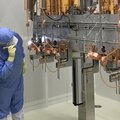
 And here I was thinking I was being overly enthusiastic with my descriptions of working at CERN
And here I was thinking I was being overly enthusiastic with my descriptions of working at CERN @Dan Maloney Lol.
@Dan Maloney Lol.![]() my ears popped when going down there
my ears popped when going down there

![]() ever thought about making it faster so you could experience zero-g?
ever thought about making it faster so you could experience zero-g? Awesome.
Awesome.![]() they are very very fast
they are very very fast At least there's a bathroom right off the elevator
At least there's a bathroom right off the elevator Hehe
Hehe

![]() and have to be triple redundant in their operation because huffing up the stairs in case of an emergency isn't really an option
and have to be triple redundant in their operation because huffing up the stairs in case of an emergency isn't really an option![]() what are the emergencies? helium/nitrogen leak from the magnets?
what are the emergencies? helium/nitrogen leak from the magnets?

![]() isnt there a dedicated fire crew for the complex?
isnt there a dedicated fire crew for the complex?![]() What kind of radiation protection do you use?
What kind of radiation protection do you use?![]() I'd guess "couple dozen meters of solid rock shielding"...?
I'd guess "couple dozen meters of solid rock shielding"...?
![]() there's a fob everyone I saw wearing around their neck that measures exposure
there's a fob everyone I saw wearing around their neck that measures exposure
![]() And the protection for people who have to access the machine?
And the protection for people who have to access the machine?![]()

![]() that is an image of the observation deck in the CMS cavern, the beam tube is within the concrete blocks below
that is an image of the observation deck in the CMS cavern, the beam tube is within the concrete blocks below

 Yeah, for those who saw "angels and demons" movie - there are indeed retina/iris scanners at the LHC/SPS access doors. Everything else in this movie is BS, but the scanners are true.
Yeah, for those who saw "angels and demons" movie - there are indeed retina/iris scanners at the LHC/SPS access doors. Everything else in this movie is BS, but the scanners are true.![]() the door interlocks are something... there's an rf fob, iris scanners, etc.
the door interlocks are something... there's an rf fob, iris scanners, etc.
![]() do you have a picture of one of the switches?
do you have a picture of one of the switches?![]() +
+
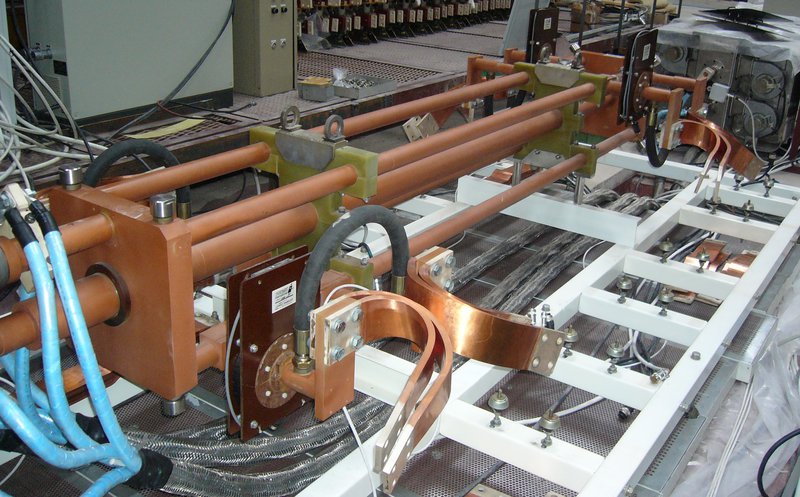
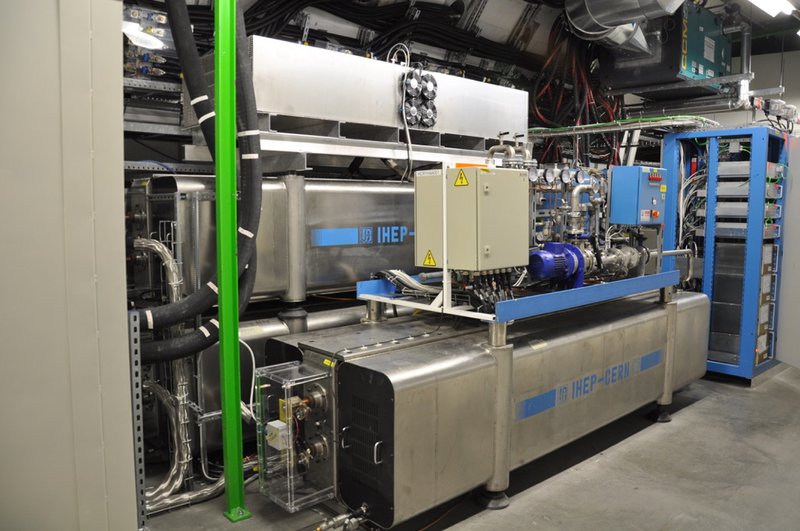


![]() Ah, I've seen those during open days in UA43
Ah, I've seen those during open days in UA43 Me too! :-)
Me too! :-)![]() the red phenolic boxes are the actuators?
the red phenolic boxes are the actuators? Amazing stuff...
Amazing stuff...


![]() is that chamber within an additional vacuum chamber or immersed in dielectric oil or some such thing?
is that chamber within an additional vacuum chamber or immersed in dielectric oil or some such thing?


![]() quite a pop when that thing does it's job...
quite a pop when that thing does it's job...
![]() when energized? or actuation not while electrified?
when energized? or actuation not while electrified?

 yeah. one sector of the LHC has a few henries (H) of inductance. And a 14kA nominal current. I leave the calculation of the energy stored in the magnets as the homework :D
yeah. one sector of the LHC has a few henries (H) of inductance. And a 14kA nominal current. I leave the calculation of the energy stored in the magnets as the homework :D

 Agreed.
Agreed.![]() seriously amazing.
seriously amazing.

 How very ironic that I am this late to the hack chat - I was trying out the CERN Choir!
How very ironic that I am this late to the hack chat - I was trying out the CERN Choir!![]()
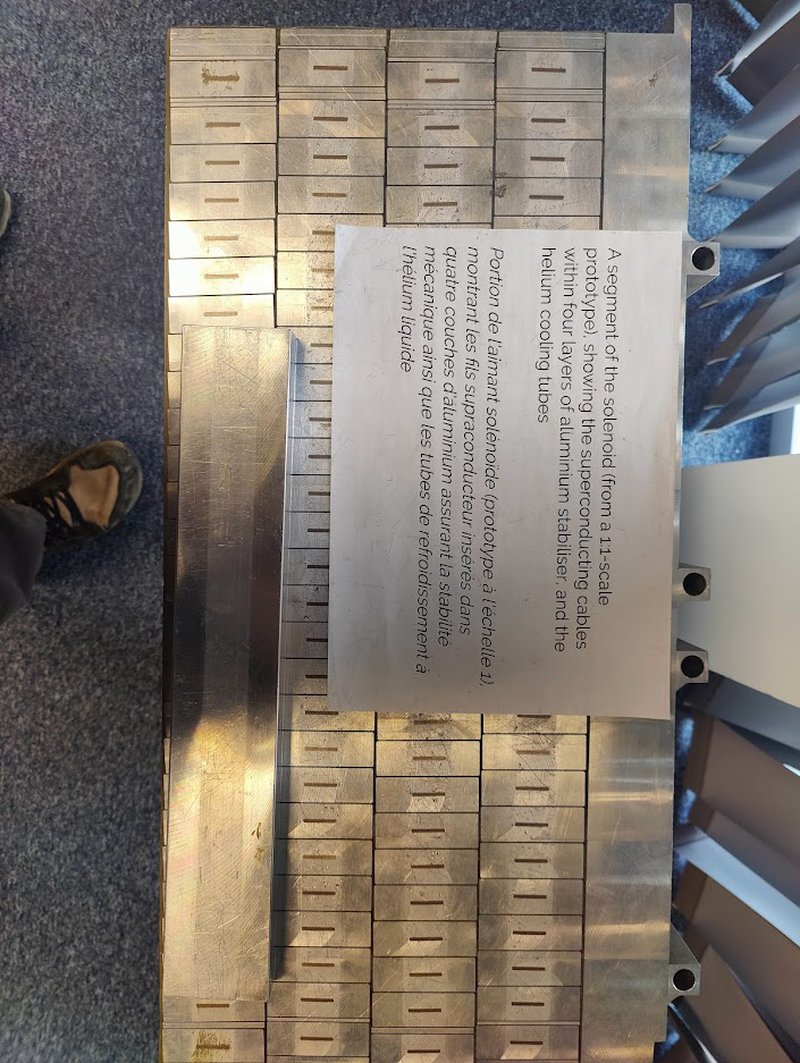
 So, I've got to drop off now, but feel free to keep chatting. Daniel, thanks for the time today, this was great. And thanks to Thomas too -- great insights into the workings of CERN, it was a lot of fun. And thanks to everyone for the great questions. Transcript coming up soon.
So, I've got to drop off now, but feel free to keep chatting. Daniel, thanks for the time today, this was great. And thanks to Thomas too -- great insights into the workings of CERN, it was a lot of fun. And thanks to everyone for the great questions. Transcript coming up soon. I'm a Technical Student, just started this month, so I would've loved to soak up some details here ^^
I'm a Technical Student, just started this month, so I would've loved to soak up some details here ^^ Yes, I'll be posting a transcript in a few minutes
Yes, I'll be posting a transcript in a few minutes

![]() oooh, my host told me that and im now failing the pop quiz. 5?
oooh, my host told me that and im now failing the pop quiz. 5?

![]() I remember it being miniscule, especially next to the standard coils used for some of the dipoles.
I remember it being miniscule, especially next to the standard coils used for some of the dipoles.![]() I heard a story...
I heard a story... Oh, I actually know a little about that! I started in the Quench Detection / Protection systems.
Oh, I actually know a little about that! I started in the Quench Detection / Protection systems.

![]() by high temp, you still mean quite chilly though correct? not high temp as in 30c
by high temp, you still mean quite chilly though correct? not high temp as in 30c


![]() ah yes, balmy.
ah yes, balmy. Haha, I will do that, he's my supervisor @daniel valuch
Haha, I will do that, he's my supervisor @daniel valuch If in the future the uQDS system works better/worse, it's my fault. I'm learning how to change the VHDL code to add some things to it.
If in the future the uQDS system works better/worse, it's my fault. I'm learning how to change the VHDL code to add some things to it.

 I would not want to be the one to cause another event like that, don't worry :P
I would not want to be the one to cause another event like that, don't worry :P![]() the dielectric changes properties with temperature. can it be used to diagnose the cable state while running?
the dielectric changes properties with temperature. can it be used to diagnose the cable state while running?

![]() there may also be quite some overlap with the field of software-defined radio.
there may also be quite some overlap with the field of software-defined radio.
 I think someone in my dept. is working on a very interesting AC analysis of the superconducting magnets too. Wonder how he's doing it...
I think someone in my dept. is working on a very interesting AC analysis of the superconducting magnets too. Wonder how he's doing it...
![]() 12 Gsps. WHOA. at how many bits?
12 Gsps. WHOA. at how many bits? yes
yes![]() I heard something like 2Pb for a total event data set in ATLAS
I heard something like 2Pb for a total event data set in ATLAS
 Yeah, but that's probably just the filtered data, events that were deemed interesting enough...
Yeah, but that's probably just the filtered data, events that were deemed interesting enough...
![]() that's... VERY impressive.
that's... VERY impressive.
 Dan Maloney
Dan Maloney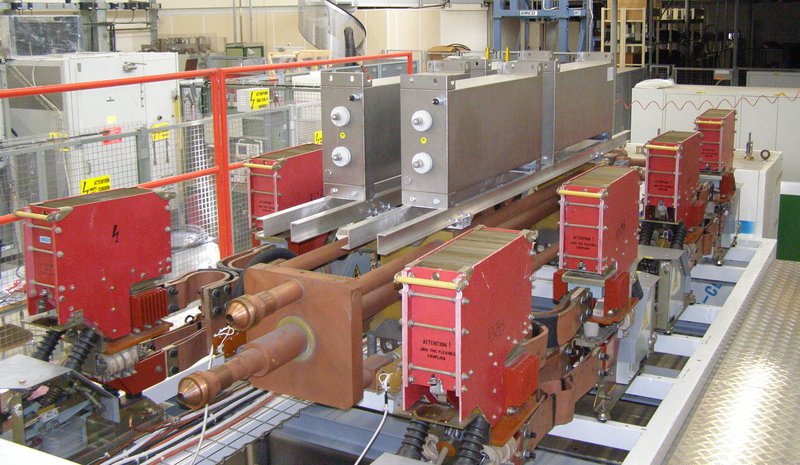
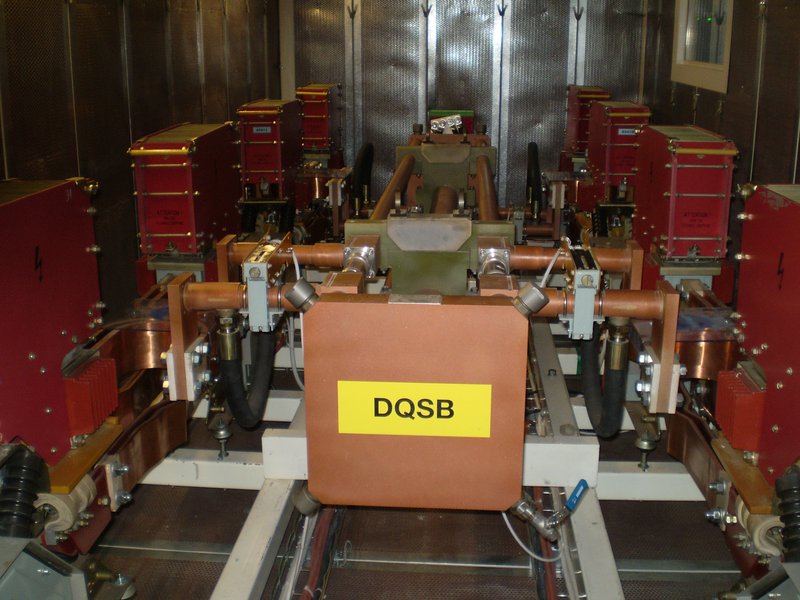

Discussions
Become a Hackaday.io Member
Create an account to leave a comment. Already have an account? Log In.